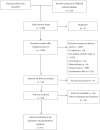Keeping People with Dementia or Mild Cognitive Impairment in Employment: A Literature Review on Its Determinants
- PMID: 32013095
- PMCID: PMC7037722
- DOI: 10.3390/ijerph17030842
Keeping People with Dementia or Mild Cognitive Impairment in Employment: A Literature Review on Its Determinants
Abstract
Background: Approximately 10-20% of people with early onset dementias (EOD) or mild cognitive impairment (MCI) are aged under 65 and, due to extended working life and increasing prevalence of dementias, they more and more frequently will be present in the active workforce. This review aimed to synthesize the available information about the ability of people with EOD or MCI to retain their participation in the labor workforce. Methods: We searched SCOPUS and EMBASE for peer-reviewed papers that reported studies assessing work ability in employees with EOD or MCI that were published in the period of January 2010 to August 2019. Results: We selected four publications, in which 1012 participants with EOD or MCI were enrolled (41.2% males). Cognitive difficulties rather than motor dysfunction were found to reduce patients' ability to work. Two main themes emerged: management of dementia in the workplace and the impact of symptoms on working status. Conclusions: EOD and MCI impact on workforce participation by determining problems in executive functions. Although this review was based on a small sample of studies, it can be shown that support in the workplace may act as a facilitator to enhance workforce participation, and occupational health professionals can help patients with EOD or MCI continue working as much as possible.
Keywords: dementia; employment; public health; work engagement; work performance.
Conflict of interest statement
The authors declare no conflict of interest.
References
-
- Thakur T.K., Albanese E., Giannakopoulos P., Jette N., Linde M., Prince M.J., Steiner T.J., Dua T. In: Neurological disorders. Mental, Neurological, and Substance Use Disorders: Disease Control Priorities. 3rd ed. Patel V., Chisholm D., Dua T., Laxminarayan R., Medina M., editors. The International Bank for Reconstruction and Development/The World Bank; Washington, DC, USA: 2016. - PubMed
-
- Garre-Olmo J., Genís Batlle D., del Mar F.M., Marquez D.F., de Eugenio Huélamo R., Casadevall T., Turbau Recio J., Turon Estrada A., López-Pousa S. Incidence and subtypes of early-onset dementia in a geographically defined general population. Neurology. 2010;75:1249–1255. doi: 10.1212/WNL.0b013e3181f5d4c4. - DOI - PubMed
Publication types
MeSH terms
LinkOut - more resources
Full Text Sources
Medical


